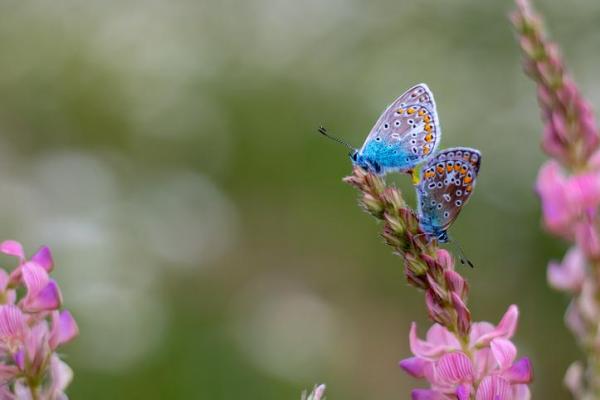
The life cycle of butterflies is one of nature's most interesting processes. The birth of these insects requires several stages, during which they undergo incredible transformations. Not only is this process detailed, but butterfly metamorphosis is also incredibly interesting.
Do you want to know how butterflies are born, in addition to finding out where they live and what they eat? Keep reading here at AnimalWised to discover everything you need to know about how butterflies are born, as well as some fun and interesting butterfly facts.
What do butterflies eat?
During a butterfly’s adult stage, a butterfly will mainly feed on nectar from flowers. A butterfly’s mouthpiece, also referred to as a proboscis, forms into a spiral tube that is capable of stretching. This tube allows butterflies to reach the nectar in any type of flower.
Thanks to this feeding system, butterflies help to spread pollen (which indirectly attaches to their legs). This means that butterflies are considered an important pollinating agent. So, you may also be wondering,‘‘What do butterflies eat before they become adults?’’ Once a butterfly hatches, they receive their first nutrients from the egg from which they hatched. Later, during their larval or caterpillar stage, butterflies consume a large amounts of leaves, fruits, branches and flowers.
Some butterfly species feed on smaller insects, and less than 1% of butterfly species feed on other butterflies.
For more about the importance of pollinating agents, we recommend reading our article where we list 15 animals that pollinate.

Where do butterflies live?
Butterflies are distributed all over the world. In fact, there are hundreds of butterfly species and subspecies, including some varieties that are able to withstand icy polar temperatures.
Most butterfly species, however, prefer to live in warmer ecosystems with spring temperatures. As for habitats, they are found in those with abundant vegetation, where they can easily access food, protect themselves from predators and find spaces to lay their eggs after mating.
For more, we recommend reading our article where we list some fascinating facts about butterflies you did not know.
How do butterflies reproduce?
Butterfly reproduction has two stages: courtship and mating. During courtship, males perform pirouettes in the air or remain static on branches. In both cases, they emit pheromones to attract the females. The females also release pheromones in order for the male to find them, even when miles away.
Once the male finds the female, it beats its wings onto its antennae to impregnate it with small scales full of pheromones. Once done, the mating process begin.
A butterfly’s reproductive organs are found in its abdomen. When mating, male butterflies use clasping organs to grab onto the females, while they both face the opposite direction. The male introduces his reproductive organ into the female and releases the sperm sac, with which he fertilizes the eggs that are inside his partner.
Once the mating process is finished, the female butterfly places between 25 and 10,000 eggs in different spaces on a plant: branches, flowers, fruits and stems. These spaces become egg shelters.
Butterfly life expectancy
Now, how long does a butterfly live? Butterfly Life expectancy varies according to the species, its access to food and its surrounding climatic conditions. Some live between 5 and 7 days, while others have a life cycle of 9 to 12 months. A butterfly’s size also greatly influences its life expectancy, the larger the butterfly, the longer it will live.

Life cycle of butterfly
Butterfly birth passes through several stages from the moment the female lays her butterfly eggs into plants. Butterfly metamorphosis passes these following stages:
1. Butterfly egg
Butterfly eggs measure between 0.5 and 3 millimeters. Depending on the species, they can be oval, long or spherical. They vary in color from white to gray and almost completely black in some species. The maturation period of these eggs varies on the individual, but many eggs are eaten by other animals during this stage.
2. Caterpillar or larva
Once the egg has hatched, the caterpillar begins to feed on proteins found inside the egg. Then, they start feeding on the plant surrounding it. During this period, the caterpillar moves its exoskeleton, thereby growing and doubling in size (in a short time).
3. Pupa
Once its necessary size has been reached, the larval period is considered over. The caterpillar's body then increases its hormone levels and behavioral changes begin. It takes on the chrysalis form.
Once the butterfly chrysalis is built, the caterpillar starts the last phase of metamorphosis. Within the chrysalis cocoon, the nerves, muscles and caterpillar's exoskeleton dissolves to give rise to new tissues.
4. Adult butterfly
Depending on the species and the climatic conditions, the caterpillar to butterfly process will vary in time. During the lightest day, once formed completely, the butterfly will begin to break the chrysalis with its head until it emerges. Once outside, it will take roughly 2 to 4 hours for it to fly. During this period, the wings will pump fluids to all parts of its body which are still compressed by the pupa position.
When pumping fluids, the ribs of the wings tense and unfold, while the rest of the exoskeleton's cuticle hardens. Once this process is completed, the butterfly takes flight in search of a mate.
For more, read all about animals that go through metamorphosis.

If you want to read similar articles to How is A Butterfly Born? - Butterfly Life Cycle, we recommend you visit our Facts about the animal kingdom category.
- Calvo, R. "Reproducción de Oenomaus ortignus (Lepidoptera: Lycaenidae) en Barva, Heredia, Costa Rica". Revista de Biología Tropical, 56 (1) 1998.
- Morales Mafla, J.; Ortiz Celorio, M. (2003). Reproducción en cautiverio de tres especies de mariposas (Lepidoptera: Rhopalocera) con fines de educación y conservación en el Zoológico de Cali. Universidad Autónoma de Occidente, Santiago de Cali.
- Pisanty, I.; Caso, (2006). M. Especies, espacios y riesgos. Monitoreo para la conservación de la biodiversidad. Instituto Nacional de Ecología, México.